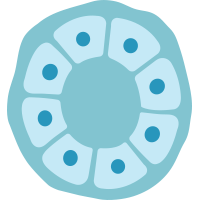
Mammary Cell News
Mammary Cell News is an online resource covering the latest research into breast cancer and mammary cells.
The Vps13-Like Protein BLTP2 Regulates Phosphatidylethanolamine Levels to Maintain Plasma Membrane Fluidity and Breast Cancer Aggressiveness
[Nature Cell Biology] Scientists found that bridge-like lipid transport proteins (BLTPs) facilitated the growth of a triple-negative breast cancer cell line and sustained its aggressiveness in an in vivo model of metastasis, suggesting that maintenance of plasma membrane fluidity by BLTP2 may be critical for tumorigenesis in humans.
Autophagy-Targeted NBR1-P62/SQSTM1 Complexes Promote Breast Cancer Metastasis by Sequestering ITCH
[Nature Cell Biology] Investigators showed that autophagy normally suppresses breast cancer metastasis by enabling the clearance of NBR1–p62/SQSTM1 complexes that instruct p63-mediated pro-metastatic basal differentiation programs.
p95HER2, a Truncated Form of the HER2 Oncoprotein, Drives an Immunosuppressive Program in HER2 Breast Cancer That Limits Trastuzumab Deruxtecan Efficacy
[Nature Cancer] Researchers demonstrated that p95HER2, a truncated form of human epidermal growth factor receptor 2 (HER2), drives immune evasion in HER2-positive female breast cancer, enhancing tumor growth and conferring therapy resistance.
pH-Triggered Delivery of Pirarubicin-Gemcitabine Duo Using Polymeric Nanoparticles for Synergistic Breast Cancer Therapy
[Nanoscale Horizons] Researchers investigated the development of pirarubicin and gemcitabine co-loaded polymeric nanoparticles for synergistic activity against breast cancer cells.
Discovery of Diaryl Piperidone-Sulfonamide As a Novel Dual-Target Inhibitor of STAT3/CAIX Inducing Ferroptosis in Triple-Negative Breast Cancer Cells
[Journal of Medicinal Chemistry] A series of diaryl piperidone-sulfonamide derivatives were designed as dual inhibitors of STAT3/CAIX and ferroptosis inducers for triple-negative breast cancer
Chimeric Diphtheria Toxin-CCL8 Cytotoxic Peptide for Breast Cancer Management
[Molecular Oncology] The specificity of a chimeric cytotoxic peptide was confirmed in vitro by testing the cytotoxic activity of breast cancer cells overexpressing CCR5, a major CCL8 receptor, and by a neutralizing anti-CCL8 antibody they developed.
M1 Macrophage Extracellular Vesicles and TLR3 Agonist Nanoparticles Down-Regulate Immunosuppression and Metastasis Via AKT/TAM in Triple-Negative Breast Cancer
[Molecular Carcinogenesis] Macrophage type 1-derived extracellular vesicles were isolated and combined with PLGA nanoparticles loaded with the TLR3 agonist poly I:C as a therapeutic strategy to investigate their antitumor activity by downregulating tumor immune escape in the tumor microenvironment of breast cancer.
Liquid Biopsy in Breast Cancer: Clinical Implications of ctDNA and CTCs in Diagnosis, Treatment, and Monitoring
[Molecular and Cellular Biochemistry] The authors focus on the clinical applications of circulating tumor cells (CTCs) and circulating tumor DNA (ctDNA) in breast cancer progression, relapse, diagnosis, and treatment response.
Susan G. Komen® Applauds US Supreme Court Decision Protecting No-Cost Access to Lifesaving Breast Care
[Susna G. Komen] Susan G. Komen® commended the United States Supreme Court’s decision to overturn a lower court decision that threatened access to preventive breast care services, including screening mammography, risk-reducing medications for high-risk individuals, and genetic counseling and testing for some with a personal or family history of breast or related cancers.
CREPT is required for the metastasis of triple-negative breast cancer through a co-operational-chromatin loop-based gene regulation.
[Molecular cancer] Researchers reported that CREPT/RPRD1B, which exhibits somatic gene copy-number amplifications and elevated expression, correlated with poor patient survival and drives TNBC metastasis.
Multi-Omics Analyses of the Heterogenous Immune Microenvironment in Triple-Negative Breast Cancer Implicate UQCRFS1 Potentiates Tumor Progression.
[Experimental Hematology & Oncology] Scientists offered innovative perspectives on comprehending the heterogeneity within the TME of TNBC, thereby facilitating the elucidation of TNBC biology and providing clinical recommendations for TNBC patients' prognosis, such as IL32high Treg infiltration, Malignant Cell Index evaluation, and UQCRFS1 expression.
Nanoscale Structural Dynamics of Cell Edges in Breast Tumor Cells Revealed by Scanning Ion Conductance Microscopy.
[Nanoscale] Researchers utilized time-lapse scanning ion conductance microscopy to visualise subcellular nanoscale structural dynamics at the edges of breast cancer cells.
For over a decade, Mammary Cell News has been keeping the global scientific and medical communities informed about the latest research, reviews, and news in the field of mammary tissues. Our editors gather publications on the topic of mammary cell differentiation and characterization, as well as the progression and treatment of breast cancer. We also keep scientists up-to-date on the latest policy changes, job postings, and events.

 Cancer Stem Cell News
Cancer Stem Cell News Cell Therapy News
Cell Therapy News Dermal Cell News
Dermal Cell News Endothelial Cell News
Endothelial Cell News ESC & iPSC News
ESC & iPSC News Extracellular Matrix News
Extracellular Matrix News Hematopoiesis News
Hematopoiesis News Hepatic Cell News
Hepatic Cell News Human Immunology News
Human Immunology News Immune Regulation News
Immune Regulation News
 Intestinal Cell News
Intestinal Cell News Mammary Cell News
Mammary Cell News Mesenchymal Cell News
Mesenchymal Cell News Muscle Cell News
Muscle Cell News Neural Cell News
Neural Cell News Organoid News
Organoid News Pancreatic Cell News
Pancreatic Cell News Prostate Cell News
Prostate Cell News Pulmonary Cell News
Pulmonary Cell News
